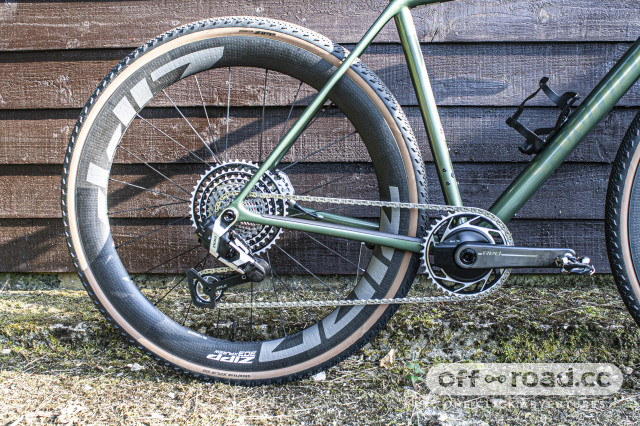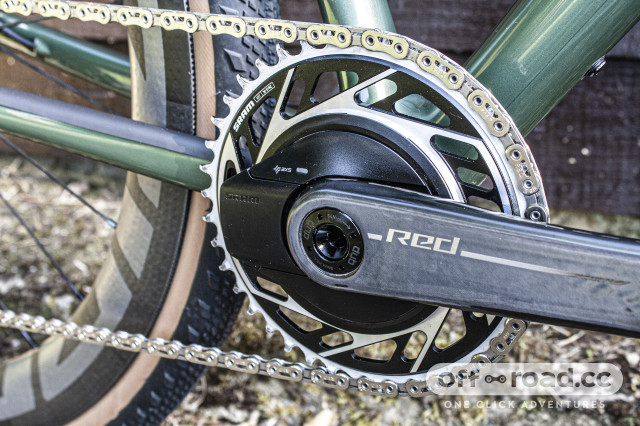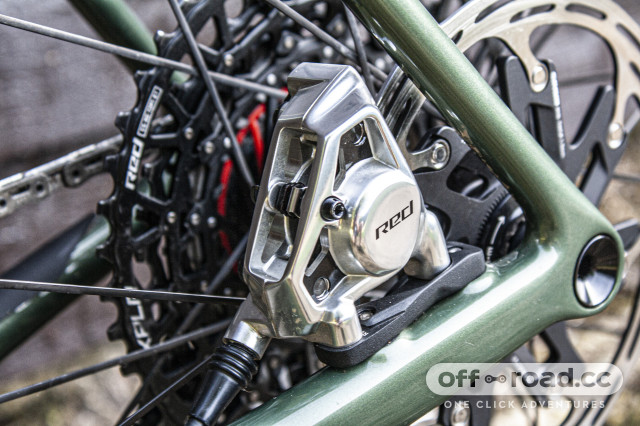SRAM has been developing drivetrains for gravel before it was even a thing, with many of the brand's product developers dabbling with 32-35mm tyres and tubes on cyclo-cross bikes back in 2013 already. But a lot has changed since those early pioneering days and, as gravel has become more mainstream, riders have naturally leaned towards wanting premium gravel-specific products.
- Best gravel bikes under £1500 in 2023
- RockShox rear shocks 2023
- SRAM mountain bike brakes 2023 - Level, G2 and Code models
The definitive need for speed and gravel optimisation started back in 2019 with the release of SRAM AXS where riders began to swap and pair mountain bike components with road groupsets – integration with Eagle AXS ramped things up even further yet there still wasn’t a super-premium drivetrain solution for gravel racing. Enter the all-new SRAM Red XPLR AXS groupset.
While it borrows a few components from the SRAM Red AXS groupset launched two months ago, this sophisticated gravel-specific groupset has taken the fight to Shimano and Campagnolo in terms of refinement, performance and specification but how does it perform in reality?
We’ve been testing the groupset for the past few weeks and have all the details on what makes it tick, including our definitive verdict.
SRAM Red XPLR AXS - Technical details
After much research and market sampling, SRAM decided to build the new Red XPLR groupset around the 1x mantra, citing this configuration represents between 55-60% of the market – and the brand reckons this figure is going to get even bigger in the future.
Let's get into the individual components that make up the SRAM Red XPLR AXS groupset.
For starters, it's worth noting that the controls, shifters, calipers, rotor and chain are shared with the brand's road-going Red AXS groupset and I'll touch on each of these components a little later. This sense of cross-compatibility and shared parts usage has become a cornerstone of SRAM's ethos so there are no surprises with this move.
The total system weight of a SRAM Red XPLR AXS groupset comes in at 2,488g (90g lighter than the previous iteration's 2,578g) and can be broken down as follows: cassette (288g), bottom bracket (76g), crankset with power meter (516g), rear derailleur (375g), shioft-brake system (692g), chain (236g), rotors (280g) and battery and wiring (24g).
Rear derailleur - £700, 375g
The rear derailleur is a completely new component that attaches to the frame by way of the universal derailleur hanger (UDH) interface – something we've discussed and reviewed in detail on off.road.cc with the SRAM GX Eagle AXS Transmission groupset. Essentially, it eradicates the need for a hanger and centres the derailleur on the wheel axle for perfect shifting. This system has proved to be impact-resistant and makes transporting your bike to and from events via aeroplane a simple and trouble-free experience – no bent hangers here.
There are other benefits, too, such as easy setup and assembly as there are no adjustment screws (no b-tension or high- or low-limit screws) – it's set and forget. Before you ask, the SRAM Red XPLR AXS derailleur does share some similarities with Transmission. This includes the full-mount attachment assembly, flat-top chain design and narrow-wide tooth profiles of the X-Sync chainrings. Of course, it's also built around 1x with a parallelogram design and clutch based on the Eagle Transmission. Apart from providing better chain management than before, the design eradicates chain sag and the likelihood of throwing the derailleur into the spokes.
The big differences between the Red XPLR AXS rear mech and the Eagle Transmission come from the user case model. Red XPLR AXS prioritises shift speed and smooth gear ratio jumps over the Transmission's shifting under load functionality. If you look at both cassettes side-by-side, you'll notice Transmission has X-Sync across the cogs for secure chain management when shifting under load. The Red XPLR cassette is more traditional in terms of tooth profile but still provides impressive shifting when the chain is tight.
The new SRAM Red XPLR AXS groupset is only compatible with frames that utilise the UDH interface, which unfortunately renders old frames obsolete. Frames will need a minimum chainstay length of 415mm, a wide crank spindle with a 47.5mm chain line and an XDR driver body on the rear hub. Regarding cross-compatibility, the Red XPLR AXS rear mech can't be used on a mountain bike and is designed for drop-bar use only.
For road and all-road builds, the Red XPLR derailleur is compatible with a 1x aero crankset and standard-width spindle – granted the frame conforms with the requirements listed above.
Another neat feature is the Magic Pulley Wheel system that allows the chain to keep moving if a stick is wedged into the lower pulley wheel. The system uses a limited-slip mechanism that allows the upper section of the pulley to turn independently of the lower main wheel body.
Cassette - £600, 288g
The super-lightweight cassette weighs just 288g and was designed for sweet-spot riding. It features a wide-range 10-46T gearing range spread over 13 sprockets and can be broken down as follows: 10, 11, 12, 13, 15, 17, 19, 21, 24, 28, 32, 38, 46 – the final three sprockets are manufactured from aluminium. These 13 cogs provide a combination of good climbing gears and top speed, with the only noticeable step-ups coming when changing into the 32, 38 and 46 cogs.
Despite the extra cog, the cassette fits a normal XDR driver body and uses the same 12x flat-top chain as regular Red AXS. SRAM achieved this feat as a result of the hangerless rear mech and the clever concave dishing of the largest 46T cog.
Chain - £90, 236g
SRAM Red XPLR AXS uses the same chain as Red AXS. The hollow pin design is lighter, stronger and quieter than a solid-plate chain and drops 13g from the previous generation. While it's compatible with all AXS 2x12 groupsets, mountain bike and road chains are optimised differently and should be used in their respective applications.
Crankset with power meter - £1,100, 516g
The crankset and power meter use a thread-mount interface introduced on Eagle. The benefit of this system is that the chainrings are replaceable and easily swapped out for races. The crankarms are 29g lighter than before thanks to a new carbon layup and hollow design and are available in 160, 165, 170, 172.5 and 175mm lengths. Chainrings are available in sizes ranging from 38-46T (38, 40, 42, 44 and 46T).
As previously mentioned, the power meter is a spider-based unit featuring a proprietary thread-on chainring system that allows chainring swapping on the fly (a thread-mount chainring removal tool is required). Not only does it provide a 200-hour battery life but the maximum deviation of 1.5% puts it up there with the most accurate power meters on the market.
Shift/brake system - £1,350, 692g
The entire control layout and braking system is the same as Red AXS 2x and comes as a result of four years' worth of ergonomic refinement. The biggest stand out is the comfort, which minimises hand fatigue and improves finger wrap around the lever for better braking. The controls are a little longer than before and ship with a short-throw lever action.
The piston layout has changed with a push-piston design replacing the pull-piston configuration. The raised pivot location has resulted in a mechanical advantage that requires less force to activate the brake. This gives better performance and 80% less effort when braking from the hoods and 33% less effort in the drops.
The reduced circumference of the body on the hoods and slimmer profile aids in a better finger position – and allows for one-finger braking. This can be further tweaked with reach adjustment. The controls can also be programmed to control a RockShox Reverb dropper post and Hammerhead cycling computer.
In terms of braking hardware, the two-piece caliper is all-new and features a piston that is positioned further outboard, which, in theory, applies the pistons and pads to a more useable side of the rotor. The result is less brake noise and better stopping performance. The rotors are new units, too, and utilise a redesigned braking track.
SRAM Red XPLR AXS - Performance
For SRAM, the big focus for the RED XPLR AXS was shift speed and, while we have heard conflicting opinions about the delayed shifting performance of the SRAM Transmission, the shifting here is fast and precise. In fact, it's not too removed from non-UDH shifting performance – that said, I have noticed shifting up to easier gears is quicker than shifting down to the harder gears.
I tested the groupset on terrain spanning mild gravel to corrugated hardpack and singletrack. Chain slap is minimal and shifting is direct and crisp under load, which inspires confidence should you enter a technical climb in the wrong gear.
The gearing spread is spot on. The 40T in combination with the 10-46T cassette provides ample range for most gravel scenarios. In and around the Surrey Hills, where I do most of my riding, you don't need anything more – the top speed afforded by the 40-10 is ample. You'll only spin out on fast descents or long straights with a negative gradient, and the granny gears up top mean even the steepest climbs are adequately dispatched.
I also managed to put the Magic Pulley Wheel system to the test. While negotiating some foilage-covered singletrack on one of my rides, a thick branch got stuck in the lower pulley wheel – bringing the Magic Pulley Wheel into play. The system worked as described, but excess debris from the branch jammed in the cassette, forcing the chain to skip. Despite this small hiccup, I'm happy to report the Magic Pulley Wheel system does, in fact, work and isn't a pointless feature.
One of the standouts on the new groupset are the controls and brakes. The new control design is simply superb and the slimmer hood shape and ergonomics mean hand positioning feels neutral and comfortable. The quality and overall treatment of the controls are world-class with minimal gaps between the different panels and an impressive fit and finish. The shift action is precise and the entire experience is intuitive, as is the braking performance.
While I've never experienced any issues with the previous iteration of SRAM Red brakes, the new arrangement represents a substantial step up in terms of modulation and stopping power. Thanks to the improved reach-adjust, push-piston configuration and raised pivot location; one-finger braking is easy and modulation is of the highest order. The braking is rich in feel, too, which enables the rider to brake later (and even feather the brake modulation mid-corner) for better control and weight distribution over the two axles.
My test bike was also outfitted with the new Zipp 303 XPLR S wheels and Goodyear XPLR Inter tyres. Designed around a 40-45mm tyre, the wheel features a 32mm internal width, 40mm external width and 54mm deep rim profile. They certainly feel fast when negotiating open gravel roads but are also outstanding at low speed, too, thanks to the ability to run super-low tyre pressures – for me, that came in at 24/26psi front/rear. The compliance is exceptional and the speed carried through rocky and corrugated roads faster than anything else I've used.
SRAM Red XPLR AXS - Verdict
As it currently stands, the SRAM Red XPLR AXS groupset will take some doing to beat based purely on its refinement, overall performance and premium nature. SRAM has nailed the formula – particularly the parts sharing across its groupsets. Not only has this lowered manufacturing cost but also unified the corporate look and feel across all products in the portfolio. Despite this, it's still fairly dear in terms of pricing. The groupset pictured here will set you back £3,980 if you purchase it outright. To put that into context, we need to look at how it compares to its rivals – and this is tricky as, currently, there isn't anything out there able to compete on every level.
Shimano's competitor is the GRX RX825 12-speed Di2 groupset – a semi-wireless option that isn't yet available in 1x configuration. It benefits from resigned controls, a clutch-actuated rear derailleur and a 48/32T, 11-36T two-by chainset but, apart from the inclusion of wireless shifters, it hasn't moved the goal posts when looking at the model it replaces and fails to elicit the premium feel of SRAM's Red XPLR AXS groupset. What it does have up its sleeve though is a much lower asking price of £2,098.
Looking at Campagnolo, the Italian brand has the Ekar groupset, which is dedicated to gravel and also available in a more budget-friendly GT guise. Both Ekar variants come in 1x and are mechanical-only options with impressive gearing – 36T, 10-48T (Ekar GT) and 38T, 10-44T (Ekar). While Campagnolo has always had a premium allure, in practice, the Ekar groupset family is more workhorse in application than racehorse, and it shows in the pricing. £1,211 will get you Ekar GT, while regular Ekar comes in at £1,610.
SRAM has done an excellent job anticipating the rise of gravel racing and catering to that specific demographic. The Red XPLR AXS groupset is designed for the racer and it shows in every detail. From the sharp braking and shifting performance to the refined ergonomics and aesthetics, there isn't anything currently available that can match the SRAM Red XPLR AXS groupset.






















7 comments
Never thought I'd see the day that Campag became the bargain option
Very happy with Ekar on my gravel bike, and saved about 3 grand as well.
£600 for a cassette. Jesus wept. Cycling has just disappeared up its own arse.
Officially there are some details that would make it incompatible with most mountain bikes, specifically requiring a 142mm axle width, and 45 to 47.5mm chainline (cf. 55mm for SRAM Eagle). It's also not designed for use with rear suspension; the clutch is a little bit lighter, and supposedly even the chain is optimised slightly differently. I'm not going to pretend I know enough to say which of those are absolute deal breakers and which are just conservative specification, but as a package I'm inclined to say it sounds like there are enough things wrong that you wouldn't have a great time if you tried to put this on a MTB.
I would also slightly wonder why you would want to. Beyond "this one goes to 13" there doesn't seem to be much advantage over Eagle Transmission - I suppose noticeably faster shifting would be a plus point too. For mountain biking, I would want the wider range offered by the Eagle 10-52 cassette (cf. 10-46 for this one). The benefit of 13-speed is primarily smaller gaps between gears which is nice to get the cadence dialed in on the road or easy gravel, but is far less significant for mountain biking. I daresay people are more likely to go the other way and creat "mullet" gravel bikes using Eagle Transmission (in order to get that wider total gear range and lower bottom gear).
I'm sorry, what?
Barking mad. It's just a fat tyre road bike isn't it, it's all getting far too serious.
£700 for a rear mech 😳😀😂🤯
Surely a willing MTB experimenter is just going to try adding 3rd party brakes and a blipbox & blips as shifters? Unless SRAM have gone out of their way to stop it - it should work.